Gun Law Media recently hosted a discussion on red flag laws, also known as extreme risk protective orders. The conversation took place at the University of Houston Law Center, where law students engaged with the topic. The focus was on whether red flag laws have a place within the legal framework.
These laws aim to prevent potential harm by removing firearms from individuals deemed dangerous. Critics argue that such measures infringe on Second Amendment rights. Some also feel they don't effectively address the root causes of violence.

Red flag laws allow authorities to temporarily confiscate firearms from individuals who may pose a threat. The idea is to prevent harm before it happens. However, critics say this infringes on constitutional rights without due process. They also point out that these laws can be based on vague or subjective criteria.
In the discussion, concerns were raised about the criteria used to judge someone as dangerous. Some argued that behaviors like road rage or owning multiple guns shouldn't automatically trigger these laws. The lack of clear definitions can make it hard for people to comply with the law.
The panel also talked about the process involved in red flag laws. After an initial hearing, individuals are notified and given a chance to present their case. However, not everyone has access to legal representation. Without a lawyer, understanding and navigating these proceedings can be challenging.
The standard for taking away someone's firearms is another concern. The legal bar is set low, using the "preponderance of the evidence" standard. This means decisions can be made with less proof than in criminal cases. Critics argue this is an inadequate standard for infringing on constitutional rights.
The debate around red flag laws often centers on their effectiveness. Some think these laws focus too much on guns instead of addressing the actual threat. The laws don't necessarily result in reduced violence, as they may not fully tackle the person's dangerous behavior.
The panel concluded that more laws are not the answer to preventing violence. Instead, they emphasized the importance of community and family structures in shaping behavior. They argued for personal responsibility and the need for self-regulation within communities.
In the end, the conversation highlighted the complex balance between safety and constitutional rights. While the intention behind red flag laws is to prevent harm, their implementation raises important legal and ethical questions.
- HR38 Bill Introduced to Standardize Concealed Carry Nationwide in the US - January 12, 2025
- Oregon Challenges Court’s Rejection of 10-Round Magazine Ban Law - January 11, 2025
- Illinois Assault Weapon Ban Legal Battle Inches Toward Supreme Court - January 4, 2025




